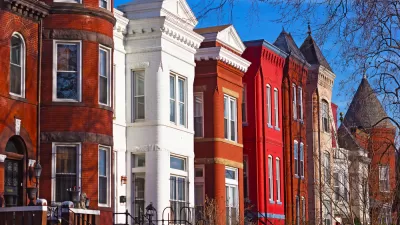The City Block examines the ongoing zoning code update in Washington D.C. relative to a zoning code tradition of maintaining restrictions on growth.
First, the post explains that the current zoning code rewrite falls short of an update to the city’s comprehensive plan, which would achieve the real work of rezoning the city. “While there are a number of substantive policy changes (all good and worth supporting – reducing parking requirements, allowing accessory dwelling units, allowing corner stores, etc.), the intent of the re-write is to look at the structure and policy of the code, rather than look for areas of the city where the zoning classification should change.”
But according to the post, the current effort mostly maintains the status quo. “As promising as the policy changes in the zoning re-write may be, they do not represent any kind of change to the basic city layout – areas currently planned for high density will see more development, and areas zoned for single-family homes will not.”
Despite the constant pressure of population growth in many cities, much zoning fails to allow for the city to expand, even if within a managed envelope; “Even with the perception of runaway development in growing cities, the amount of space that’s set aside for a physical transformation is remarkably small.” For example, the D.C. Office of Planning has identified 95 percent of the city as inappropriate for “additional height based on existing plans, historic districts, etc.”
FULL STORY: The zoning straightjacket

Alabama: Trump Terminates Settlements for Black Communities Harmed By Raw Sewage
Trump deemed the landmark civil rights agreement “illegal DEI and environmental justice policy.”

Planetizen Federal Action Tracker
A weekly monitor of how Trump’s orders and actions are impacting planners and planning in America.

The 120 Year Old Tiny Home Villages That Sheltered San Francisco’s Earthquake Refugees
More than a century ago, San Francisco mobilized to house thousands of residents displaced by the 1906 earthquake. Could their strategy offer a model for the present?

In Both Crashes and Crime, Public Transportation is Far Safer than Driving
Contrary to popular assumptions, public transportation has far lower crash and crime rates than automobile travel. For safer communities, improve and encourage transit travel.

Report: Zoning Reforms Should Complement Nashville’s Ambitious Transit Plan
Without reform, restrictive zoning codes will limit the impact of the city’s planned transit expansion and could exclude some of the residents who depend on transit the most.

Judge Orders Release of Frozen IRA, IIJA Funding
The decision is a victory for environmental groups who charged that freezing funds for critical infrastructure and disaster response programs caused “real and irreparable harm” to communities.
Urban Design for Planners 1: Software Tools
This six-course series explores essential urban design concepts using open source software and equips planners with the tools they need to participate fully in the urban design process.
Planning for Universal Design
Learn the tools for implementing Universal Design in planning regulations.
Clanton & Associates, Inc.
Jessamine County Fiscal Court
Institute for Housing and Urban Development Studies (IHS)
City of Grandview
Harvard GSD Executive Education
Toledo-Lucas County Plan Commissions
Salt Lake City
NYU Wagner Graduate School of Public Service



























